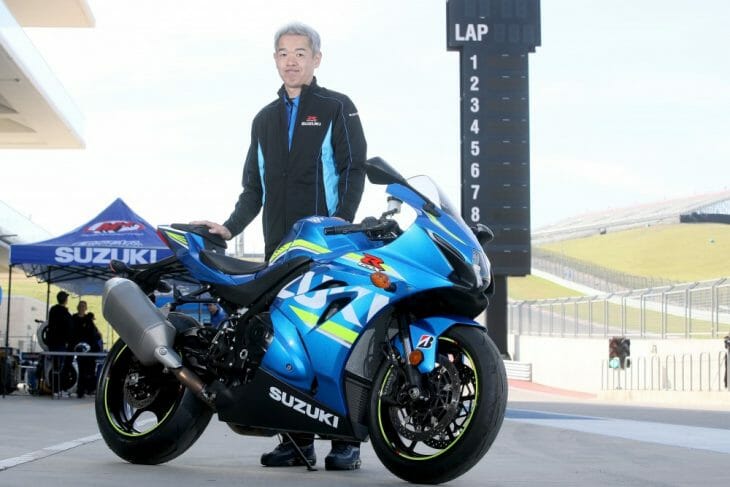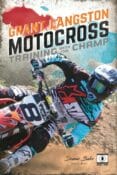
Shinichi Sahara, Chief Engineer of the new-generation 2017 Suzuki GSX-R1000 (Photo by Brian J. Nelson)
Shinichi Sahara, Chief Engineer of the new-generation 2017 Suzuki GSX-R1000 made a somewhat surprising revelation. In a very Spock-like telling, when the first prototype engine of the new GSX-R1000 was assembled and on the test bench and fired up for the first time it didn’t particularly move him. However, when the first complete motorcycle was started and began rolling away under its own power at the Suzuki plant, it was a different story. At that point, Sahara showed he was more human than Vulcan. “It was quite emotional,” he admitted.
It’s easy to understand while the very logical-thinking Sahara discovered a smile coming across his face when the first of the new generation GSX-R1000 became a reality. It was the culmination of countless hours of work by a dedicated team hoping to keep the rich legacy of Suzuki’s GSX-R alive.
Even though Sahara would likely never admit it, being the Project Leader appointed by his company to produce the newest version of the most popular sportbike of all time has to carry more than just a little pressure.
When he was high school age, Sahara began riding motorcycles. At 19 he began road racing, but “I didn’t have enough budget to continue racing because I was still a student,” Sahara explains. “Then I switched from road racing to minibike racing, just to enjoy.”
The mental image of the lanky Sahara draped over a minibike brings a smile.
After graduating from university at 24, Sahara began his career at Suzuki. The year was 1989.
“My first job at Suzuki was developing future technology,” Sahara said. “Not a production bike, but working on elements of the technology of the future.”
Think about the company mindset that gives new engineers, fresh from university, the opportunity to work with a clean sheet of paper and offer their visions of technologies their company might use or develop, gives you an idea of why Japanese makers continue to be on the leading edge of innovation.
From that point, it was a typical step-by-step engineering apprenticeship for Sahara. He began working in engine development for streetbikes, at first for smaller displacement machines and gradually working his way up to the larger bikes. “My job was working on the engine dyno and finding more and more horsepower,” Sahara explains.
At the end of 1995 Sahara moved to Suzuki’s racing department. His first few years were spent working with Suzuki’s Superbike team in the Japanese domestic MFJ Road Race Championship. Sahara’s time with the domestic team coincided with a dramatic improvement for Suzuki’s results.
It was during this time that Sahara was part of the team that developed the Suzuki TL1000R. The V-Twin machine was a big departure for Suzuki, and while the motorcycle ultimately didn’t prove to be a great racing machine, it did mark an important milestone for Suzuki, in that the TLR was the first fuel-injected sportbike for the company.
The TLR was also a big stepping stone of knowledge gain for Sahara. “I learned many things from that bike, but also it was very difficult, a very hard job” Sahara admits. “The most important thing I learned from that project was setting up fuel injection for Superbike racing.”
From there he came to work with Yoshimura Suzuki in the AMA Superbike Championship during the 1998 season when the squad was busy fielding four Superbikes, two TLRs and two GSXRs.
Again, following a logical progression, Sahara’s next assignment was two years (1999-2000) in World Superbike with riders ‘Frankie’ Chili and Katsuaki Fujiwara.
Then a really big step for Sahara came with Suzuki when he was asked to design the four-stroke MotoGP engine for Suzuki.
“Designing or drawing was not my specialty at that time, but I try,” Sahara said. “And I designed the first generation of Suzuki’s MotoGP engine. It was very difficult, but I did it.”
It was perhaps busiest time of his career for Sahara, who now in his mid-30s, was really hitting his stride inside Suzuki. He was not only entrusted with the design of the MotoGP engine, he was also still Project Leader for Suzuki’s Superbike racing efforts. Needless to say, Sahara did not have a lot of free time during this period. “I had a lot of traveling. It was very hard, but I enjoyed it,” he says.
In 2002 Sahara became technical manager of Suzuki’s MotoGP team. He traveled the world for a decade with the MotoGP squad through 2011 when Suzuki discontinued its MotoGP efforts. “That’s a story in itself,” Sahara says.
After working in Suzuki’s racing side for 16 years, Sahara found himself back in Japan fulltime, engineering production motorcycles. It was a change of pace for sure, but one that ultimately led to Suzuki calling on Sahara’s now considerable experience to revive the GSX-R1000. The global financial crisis of 2008 resulted in a nosedive for motorcycle sales in general, but it the cuts were especially felt in the sportbike segment of the market. The end result was the venerable GSX-R missed a design cycle and was largely unchanged since 2009.
The long timeframe between generations of GSX-R1000 was a blessing and a curse. Suzuki and Sahara could begin with a clean sheet of paper, but a lot was riding on the redesign. Sahara said the most important thing to him was to have solid fundamentals to begin with, one that would not have to rely so much on electronic aids to get the most out of the machine. That was the philosophy he gave to his team on designing the newest generation.
We think of state-of-the-art computer design taking out all of the guesswork with what might be the weaknesses of a new engine, but Sahara says testing prototypes still provides many answers the computers could not calculate.
“Most things can be analyzed by computer now,” Sahara says. “Some data are precise, some are not so. But nobody knows what would happen in actual engine until we build it, not only the engine, but the entire package of the bike.”
Does Sahara have shop talk with fellow engineers from the other motorcycle companies?
“Yes, we know each other,” he says. “Sometimes we will get together for coffee or for alcohol and secret is secret, I cannot say anything, but they give me sometimes, some indication of a new technology and I make note.” (Sahara grins wide.)
Fortunately for Sahara his racing background gives him the ability to throw a leg over on his latest creation at the track and enjoy firsthand the fruits of his and his team’s labors. At the recent GSX-R1000 press intro the day after the MotoGP race at COTA, Sahara was there on the track with Kevin Schwantz, Kenny Roberts, Jr. and the riding journalists, hustling the iconic Suzuki sportbike around the amazing circuit.
As the saying goes – It’s a tough job, but someone’s got to do it.
